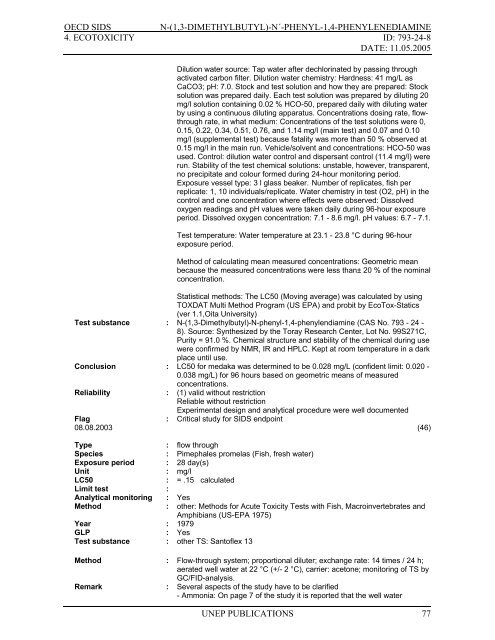N-(1,3-Dimethylbutyl)-N
N-(1,3-Dimethylbutyl)-N
N-(1,3-Dimethylbutyl)-N
Create successful ePaper yourself
Turn your PDF publications into a flip-book with our unique Google optimized e-Paper software.
OECD SIDS<br />
N-(1,3-DIMETHYLBUTYL)-N´-PHENYL-1,4-PHENYLENEDIAMINE<br />
4. ECOTOXICITY ID: 793-24-8<br />
DATE: 11.05.2005<br />
Dilution water source: Tap water after dechlorinated by passing through<br />
activated carbon filter. Dilution water chemistry: Hardness: 41 mg/L as<br />
CaCO3; pH: 7.0. Stock and test solution and how they are prepared: Stock<br />
solution was prepared daily. Each test solution was prepared by diluting 20<br />
mg/l solution containing 0.02 % HCO-50, prepared daily with diluting water<br />
by using a continuous diluting apparatus. Concentrations dosing rate, flowthrough<br />
rate, in what medium: Concentrations of the test solutions were 0,<br />
0.15, 0.22, 0.34, 0.51, 0.76, and 1.14 mg/l (main test) and 0.07 and 0.10<br />
mg/l (supplemental test) because fatality was more than 50 % observed at<br />
0.15 mg/l in the main run. Vehicle/solvent and concentrations: HCO-50 was<br />
used. Control: dilution water control and dispersant control (11.4 mg/l) were<br />
run. Stability of the test chemical solutions: unstable, however, transparent,<br />
no precipitate and colour formed during 24-hour monitoring period.<br />
Exposure vessel type: 3 l glass beaker. Number of replicates, fish per<br />
replicate: 1, 10 individuals/replicate. Water chemistry in test (O2, pH) in the<br />
control and one concentration where effects were observed: Dissolved<br />
oxygen readings and pH values were taken daily during 96-hour exposure<br />
period. Dissolved oxygen concentration: 7.1 - 8.6 mg/l. pH values: 6.7 - 7.1.<br />
Test temperature: Water temperature at 23.1 - 23.8 °C during 96-hour<br />
exposure period.<br />
Method of calculating mean measured concentrations: Geometric mean<br />
because the measured concentrations were less than± 20 % of the nominal<br />
concentration.<br />
Statistical methods: The LC50 (Moving average) was calculated by using<br />
TOXDAT Multi Method Program (US EPA) and probit by EcoTox-Statics<br />
(ver 1.1,Oita University)<br />
Test substance : N-(1,3-<strong>Dimethylbutyl</strong>)-N-phenyl-1,4-phenylendiamine (CAS No. 793 - 24 -<br />
8). Source: Synthesized by the Toray Research Center, Lot No. 99S271C,<br />
Purity = 91.0 %. Chemical structure and stability of the chemical during use<br />
were confirmed by NMR, IR and HPLC. Kept at room temperature in a dark<br />
place until use.<br />
Conclusion : LC50 for medaka was determined to be 0.028 mg/L (confident limit: 0.020 -<br />
0.038 mg/L) for 96 hours based on geometric means of measured<br />
concentrations.<br />
Reliability : (1) valid without restriction<br />
Reliable without restriction<br />
Experimental design and analytical procedure were well documented<br />
Flag : Critical study for SIDS endpoint<br />
08.08.2003 (46)<br />
Type : flow through<br />
Species : Pimephales promelas (Fish, fresh water)<br />
Exposure period : 28 day(s)<br />
Unit : mg/l<br />
LC50 : = .15 calculated<br />
Limit test :<br />
Analytical monitoring : Yes<br />
Method : other: Methods for Acute Toxicity Tests with Fish, Macroinvertebrates and<br />
Amphibians (US-EPA 1975)<br />
Year : 1979<br />
GLP : Yes<br />
Test substance : other TS: Santoflex 13<br />
Method : Flow-through system; proportional diluter; exchange rate: 14 times / 24 h;<br />
aerated well water at 22 °C (+/- 2 °C), carrier: acetone; monitoring of TS by<br />
GC/FID-analysis.<br />
Remark : Several aspects of the study have to be clarified<br />
- Ammonia: On page 7 of the study it is reported that the well water<br />
UNEP PUBLICATIONS 77
















